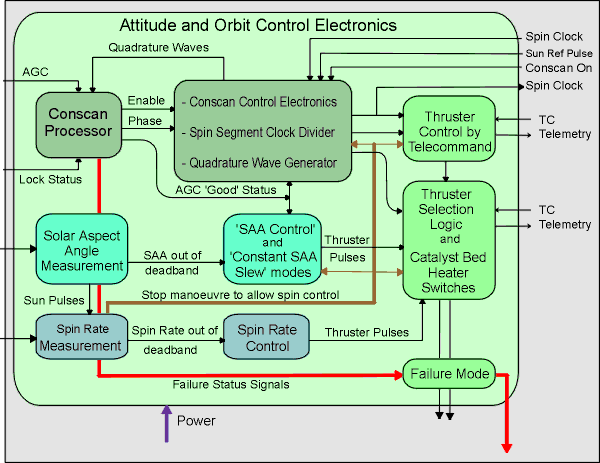AOCE - Ulysses
Attitude and Orbit Control Subsystem
Ulysses Attitude and Orbit Control Electronics
This diagram shows more detail of the connectivity between units within the AOCE. Click on an area of this image to obtain a more detailed description of the units of interest.
The Attitude and Orbit Control Electronics uses inputs from the spacecraft receivers, decoders, Sun Sensors, and ground commands to control the spacecraft spin rate, attitude, and manoeuvres. It has four main modes of operation: spin control, Solar Aspect angle control, Earth pointing attitude control using 'conscan', and thruster control by telecommand.
Conscan
The Conscan Processor takes Automatic Gain Control (AGC) signals from the receivers in the TTC Subsystem and uses them to determine the pointing error between the Earth direction and the High Gain Antenna (HGA) boresight, and to determine the direction of this offpointing. This information is then used to generate thruster pulses to move the spacecraft spin axis in the correct direction to keep the spacecraft Earth-pointing.
Spin Control
Ulysses spin rate is determined by measuring the interval between successive pulses coming from the Sun Sensors. The spacecraft spin rate is generally constant at approximately 5 rpm, however the AOCS has the ability to control the spin period under circumstances when it could vary. If the spin rate varies from 5rpm by more than 0.1rpm and the Spin Control function is operating, the AOCE will cause the spacecraft spin thrusters to fire.
Solar Aspect Angle Control
The AOCE receives Sun pulses from the Attitude Measurement Electronics (AME). The Solar Aspect Angle (SAA) is determined from the duration of the sun crossing time in any given spin cycle; since the sun crossing times are proportional to SAA, crossing time can be easily correlated with SAA. Two 'SAA deadbands' can be loaded into the AOCE by ground telecommand. The spacecraft SAA only varies slowly and is usually altered by ground-initiated manoeuvres, however the SAA Control mode allows the SAA to be regulated by the spacecraft should this become necessary. If SAA Control mode is operating, the AOCE will cause a spacecraft axial thruster to fire if the SAA drifts outside the SAA deadbands.
The Constant SAA Slew mode allows the spacecraft to slew at a constant, predetermined SAA in order to acheive a new orientation. If Constant SAA Slew mode is operating, the spacecraft will fire a number of thruster pulses to precess the spin axis at a constant SAA. If the SAA should drift outside the SAA deadbands, the AOCE will fire corrective pulses to ensure the SAA stays in the commanded range.
Thruster Control by Telecommand
Most of Ulsses manoeuvre are calculated on the ground, and loaded into the AOCE as a set of thruster pulses of a given size and direction. Routine manoeuvre consist of moving the spacecraft spin axis every 2-4 days to track the Earth; this is called a Routine Earth-Pointing Manoeuvre. Earlier in the Ulysses mission, this mode was also used to implement Trajectory Correction Manoeuvres (TCMs) that put the spacecraft on the right track to meet its destination orbit around the poles of the Sun.
A Matter of Safety
Since Ulysses is so far away from the Earth for long periods of its mission, it can take up to 55 minutes for information about possible problems during manoeuvres to reach Earth - and another 55 minutes for any corrective commands to reach the spacecraft. For this reason, the spacecraft AOCE has a limited ability to monitor the progress of its manoeuvres, and take some corrective action if there is a problem.
Three failure protection parameters are monitored by the AOCS. Solar Aspect Fail Detect will occur if the SAA drifts outside the allowed deadbands. Conscan Fail Detect will occur if the spacecraft spin axis moves more than 0.75 degrees from the Earth. Spin Fail Detect will occur if the spin rate drifts more than 0.2 rpm from its nominal 5 rpm spin rate. If any of these conditions are met, a failure signal will be generated and the Reaction Control Subsystem's Latching Valves will close, preventing further fuel from flowing to the thrusters, and terminating the manoeuvre.








































 Sign in
Sign in
 Science & Technology
Science & Technology
